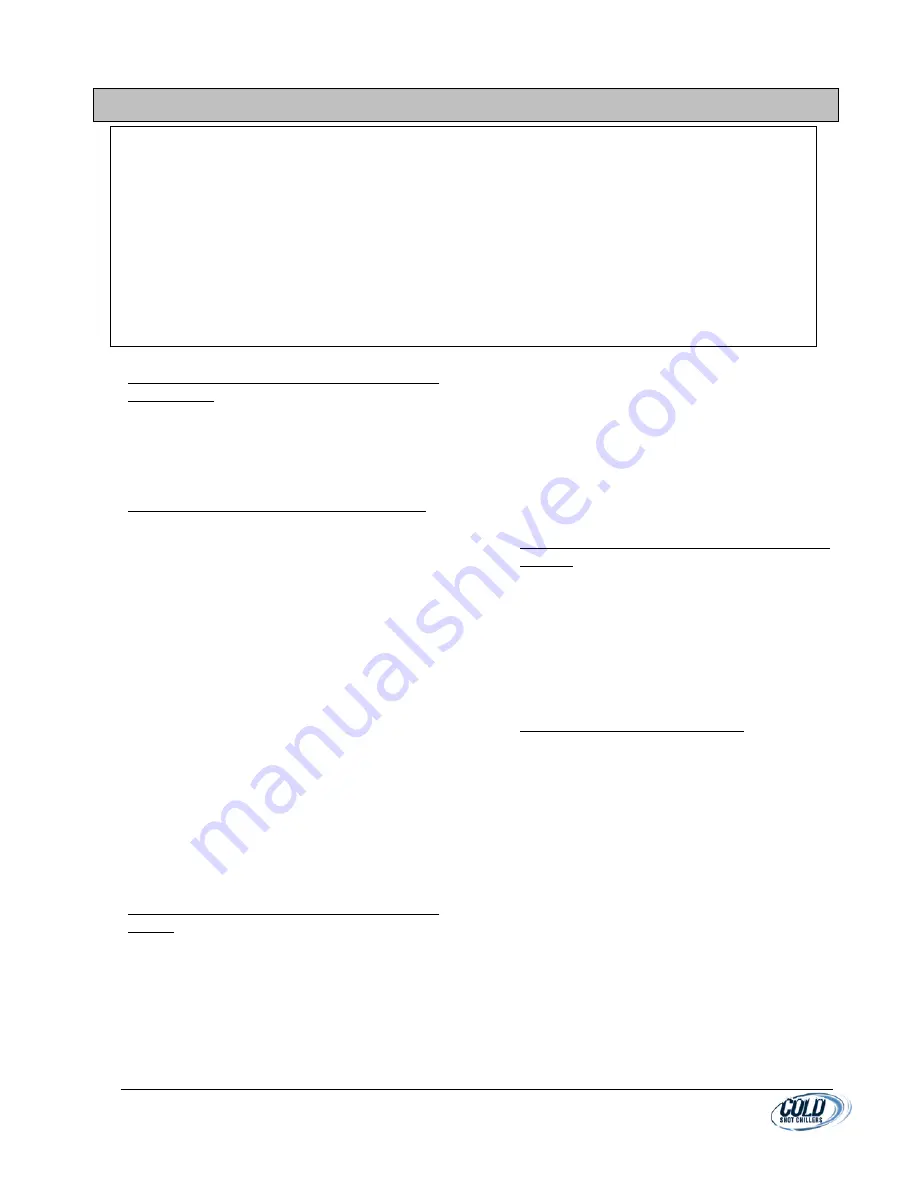
MNL_Standard-NoSpecs_ACWC-18to240-E-_(0713).docx
- 13 -
VI.
MAINTENANCE (BASIC GUIDE)
1.
REVIEW AND COMPARE SYSTEM OPERATING
PARAMETERS
a.
Review original startup checklists and any log
readings that may have been recorded to
compare with existing parameters and
conditions. Determine if further analysis is
needed.
2.
AIR COOLED CONDENSER (INSPECT AND CLEAN)
a.
INSPECT: Light should be visible through the
condenser coil for dirt or airborne particle
build-up. Check deep into the coils with a
flashlight and, if dirty, clean as needed.
b.
CLEANING: Be careful to disconnect the
power first. Protect all electrical components
from water and from water entering electrical
conduit lines, and then cover the
pump/motor, unless motor is a TEFC, to
prevent water from entering the vent ports. If
it needs to be cleaned, remove the covers of
the chiller and use water or compressed air to
blow back through the coil in the opposite
direction of air flow. Avoid any damage to coil
fins such as bending fins flat.
c.
EZ CLEAN FILTERS: If included on the
condenser, remove the filters from the unit,
and wash with water or soapy water, rinse
thoroughly, and then allow filters to dry
thoroughly before reinstallation. Reattach
when completely dry.
3.
UNIT SURFACE CLEANLINESS (INSPECT AND
CLEAN)
a.
Inspect all exposed surfaces for indications of
corrosion.
b.
Metal, air, and/or water do not always mix
well. When the proper concentration are in
the same area, then corrosion results.
Corrosion is the changing of a metal’s
properties from one material to another.
Nearly all metals are susceptible to corrosion.
One noticeable corrosion when iron and
oxygen mix resulting in Iron-Oxide or Rust.
Most commonly, the corrosion can be
removed with wire brush and/or abrasive
clothes, and then the surface can be recoated
to reduce future corrosion. For severe
environments, use a durable epoxy paint that
can create an oxygen barrier.
c.
Fasteners which are corroded should be
replaced with stainless steel fasteners.
4.
WATER QUALITY / TEST GLYCOL MIXTURE
(VERIFY)
a.
System water should be clean and free of
contaminants. If the chiller has a reservoir,
check for debris or contaminants which could
reduce the efficiency of your chiller. If the
chiller has a flow-through heat exchanger,
check for normal inlet and outlet fluid
pressure. A large pressure differential could
indicate plugged up heat exchanger passages.
5.
STRAINERS, FLUID (INSPECT/CLEAN)
a.
Fluid filters should be clear enough to allow
for proper flow and pressure in the system.
An increased fluid pressure on the system
may indicate a dirty filter.
b.
To clean, turn the system off, isolate the
process piping, if possible (if the chiller is not
isolated from the process and the strainer is
opened, then any fluid above the strainer will
drain out immediately.) After isolating the
process, use a wrench to hold the strainer
stationary while another wrench is placed on
the strainer screen cap. The wrench on the
strainer body must prevent the body from
turning in the piping. Remove the cap and the
strainer screen. Clean the screen and
reinsert, taking care not to damage by
crushing. Tighten the screen cap.
c.
Setup a schedule based on the systems
cleanliness and trends of use.
IMPORTANT
•
Always disconnect and lock out the electrical power source before attempting any connection, maintenance or
repairs. Failure to do so can cause electrical shocks, burns and death.
•
All work must be performed by a qualified service person based on the local codes and regulations of the area.
•
This guide/instruction is to be used as a guide only. An understanding of the system being worked on must be
understood before performing any service. Each equipment installation is unique and must be reviewed
carefully.
•
This is a list of basic maintenance items for your liquid chiller. The interval for this maintenance should be
determined by the duty cycle of the chiller and the environmental conditions in which it operates. Each system
may be unique, so contact the systems manager or the manufacturer for assistance.
If any questions regarding the equipment, please contact Cold Shot Chillers for assistance.
NOTE: Not performing the following will cause early unit failure and considered abuse which is not covered by warranty.














































